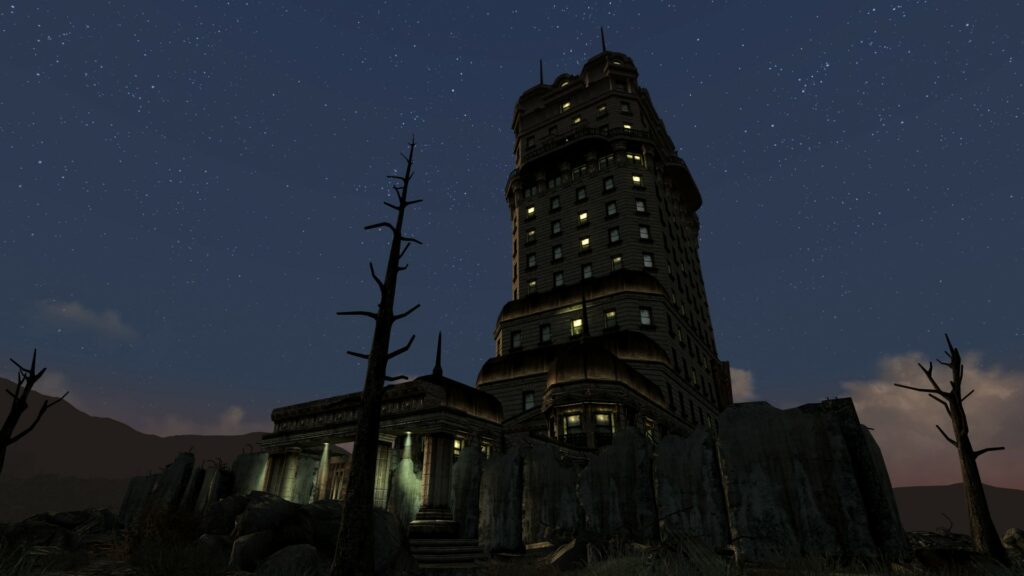
In typical Bethesda fashion, Tenpenny Tower is a simple black and white, ‘good versus evil’ deal, missing any form of subtlety or nuance. The really interesting thing, though? They seem to expect the player to automatically assume that ghouls = good, Tenpenny = bad. But if you analyse the options with even a cursory glance, it’s arguably the complete opposite. Or you could say they’re all different shades of awful.
Let’s take Tenpenny’s side first. Gustavo refuses Roy Phillips entry into the tower. Why? Because he’s a ghoul. Now okay, initially this seems like a pretty horrible reason, and could have been used to explore the realities of racism and bigotry in a post-apocalyptic setting. Especially as Gustavo raises a valid point about ghouls eventually turning feral (which is something Bethesda added and wasn’t the case in the previous games).
Roy, meanwhile, doesn’t like that Tenpenny and his residents hold the opinion that ghouls are bad simply because they’re ghouls, wants to kill everyone as a result, and is blind to his own hypocrisy. Again, that could be a pretty good thing to explore… but nope, easier to just have the player assist in small-scale genocide.
If you have a little chat with Tenpenny himself, you’ll discover that he’s actually perfectly happy for Roy to come in… if you can persuade certain important residents. On the other side of the fence, Roy says he can afford to move in, but for reasons that aren’t clear he instead wants to overrun the tower with feral ghouls and kill everyone, possibly because he’s a short-tempered arse, or because he’s turning feral himself. Maybe both.
This leaves you with the general idea that Gustavo is right to not let them in. You can tell simply from talking to Roy that he’s mentally unstable, but the game tries to frame this quest in such a way that you’ll want to side with Roy because he’s uh… the good guy? Or something?
And if you kill Roy, you get negative karma, which is one of the reasons I hate the karma system; it’s no longer a difficult moral choice that you have to decide for yourself when the game makes a point of telling you that you chose wrong. No, bad player, Bethesda has decided that Roy is morally good, and if you kill him you are therefore morally bad… regardless of how backwards that actually is when looked at critically.
In reality, Gustavo—while certainly racist against ghouls—actually has the moral high ground, because he has to think of the wellbeing of the tower’s residents first and foremost, and that means not letting in potentially unstable wingnuts like Roy.
What I will say is this: the quest itself and pretty much everything it involves is incredibly dumb and ill thought-out, which the always excellent Shamus Young covers in detail. None of it makes any real sense.
But I will at least credit Bethesda with one thing: if you ignore the ludicrous quest and actually ponder the situation itself, it does make you think pretty hard about the situation here, and how it’s not always a cut and dried situation and often involves other circumstances you’d do well to think about carefully before passing judgement. This is of course completely ruined by the karma system, but still.
I suspect this was also accidental on Bethesda’s part (remember I said the same about the Glowing Sea a couple parts back?). The problem here is that I don’t trust Bethesda’s writers, the few they actually have, and Emil Pagliarulo (lead writer and designer) is the worst of the lot. This is the guy who won writing awards for Fallout 3… somehow. Anyway, it’s simple: if I don’t trust the writer, I’m going to assume that anything interesting or higher quality than the standard fare in the game was an accident before I assume it was intended.
Worse than that, though, is the fact that this isn’t even an original idea. If you’re not into horror movies or zombie flicks, you may never have watched Romero’s Land of the Dead, which features a tower full of class divides, with the rich at the top shopping for expensive stuff with money they can’t have earned because there’s no economy any more, zombies surrounding the building which are a constant threat to the security of the tower, and… hey, this sounds strangely familiar!
Where it gets really strange is that Romero’s movie was just as incoherent as Tenpenny Tower, where it was like Romero wanted to say something about class divides, but had no idea how to actually do it in a way that wasn’t incredibly dumb, one dimensional, and shallow. Did Bethesda look at that movie and try and recreate it as a fun little nod? As Homage? Or did they actually think it had something clever to say and they tried recreating it, only to make something that was worse? I have no idea.
In any case, back to the quest itself, after that little tangent…
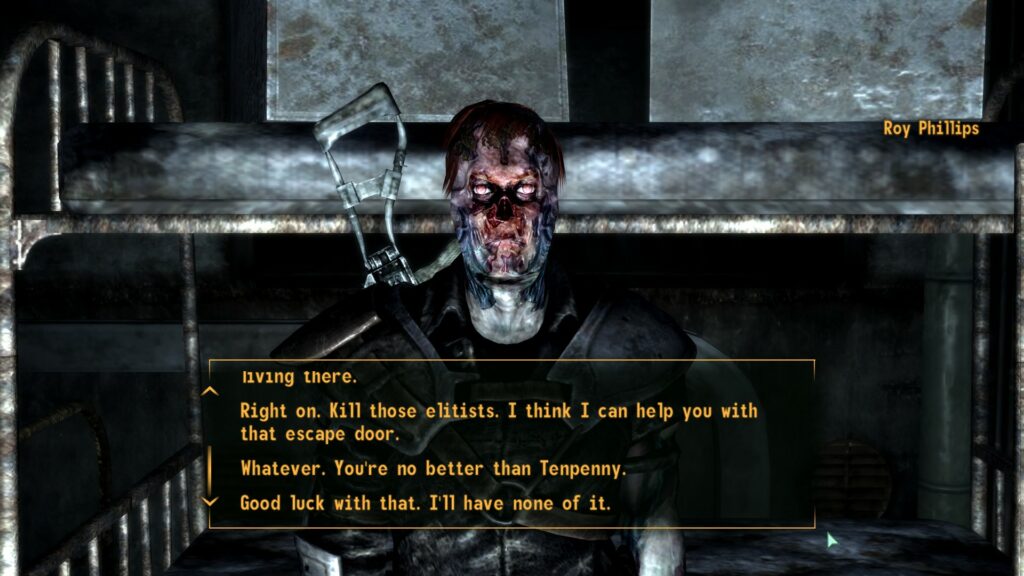
As Roy is currently set up, he’s just a bit of a hard-ass who wants entry because he thinks it’ll be nicer in the tower than where he currently lives. Okay, that’s fair, I’ll grant him that. But then the game tries to railroad the player, as it does in so many other instances. Kill everyone here, or kill everyone in Tenpenny Tower, those are pretty much your only options, because even if you take the diplomatic route, Roy kills everyone anyway.
If you’re truly role-playing this game, attempting to work around the lack of real role-playing options… then the only reasonable course of action is to simply ignore the quest entirely. Don’t play their stupid game, thereby avoiding the forced situation of having to kill one side or the other. Or just shoot Roy in the head the moment you arrive, which is the only appropriate way to deal with a zombie.
On the plus side, I suppose it’s at least one example of being able to change the world, though not necessarily for the better, and not in such a shallow way as Megaton’s ‘would you like to nuke this town for the lulz, Y/N?’. It’s a post-apoc setting, the appropriate phrase is ‘shit happens’. These choices litter New Vegas throughout—even the very first town in the game can be drastically changed (and even turned into a ghost town) depending on your actions—but in Fallout 3 they’re often absent.
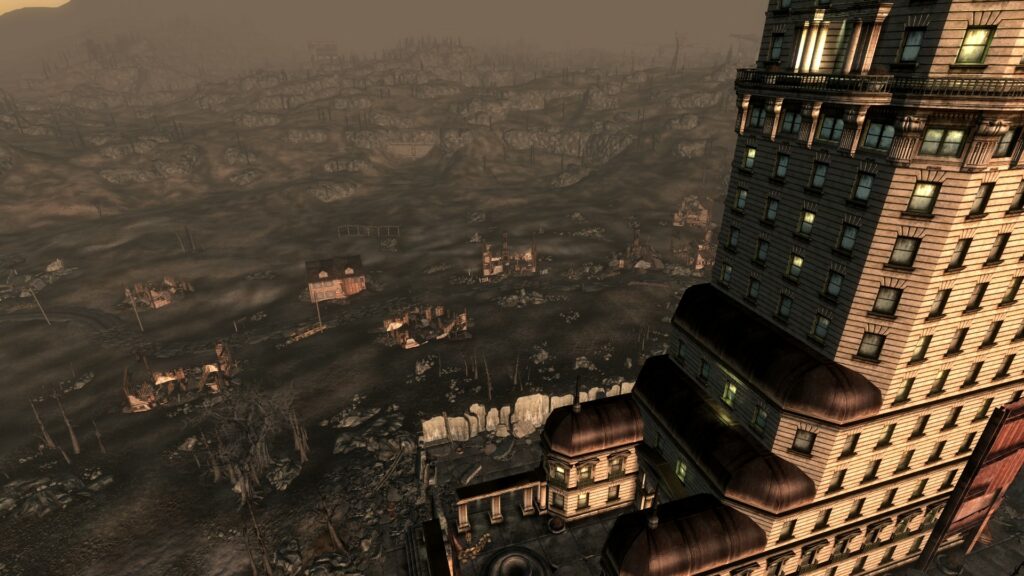
So now I’ve had a good moan about the main Tenpenny quest, let’s see how we might fix this place up. The very first thing to do is heavily accentuate the class divide theme. For this location to be even remotely viable, there needs to be some sort of pleb class of people labouring to provide for the upper classes in the tower.
How about a large slum region around the base of the tower outside the fortifications? Tenpenny can still have his high and mighty attitude, but by saying he’s more of a benevolent dictator who thinks of himself as doing the lower classes a favour by allowing them to work for him, we open up interesting avenues of conflict.
By seeing the unwashed masses far, far below, he gets a pleasant sense of satisfaction and superiority sitting up here in the fresh air, presiding over his subjects. Meanwhile, down below, the people are always aware of him and the other residents lording it over them, thanks to the huge tower being visible at all times, no matter where they are.
The slums are where food is grown, junk is scrapped, and goods of one form or another are manufactured by hand. It’ll be a combination of shanty town built from scrap, and the nearby areas built around existing structures including the Robco factory. Post-apocalyptic Midgar, effectively, just with less pizza.
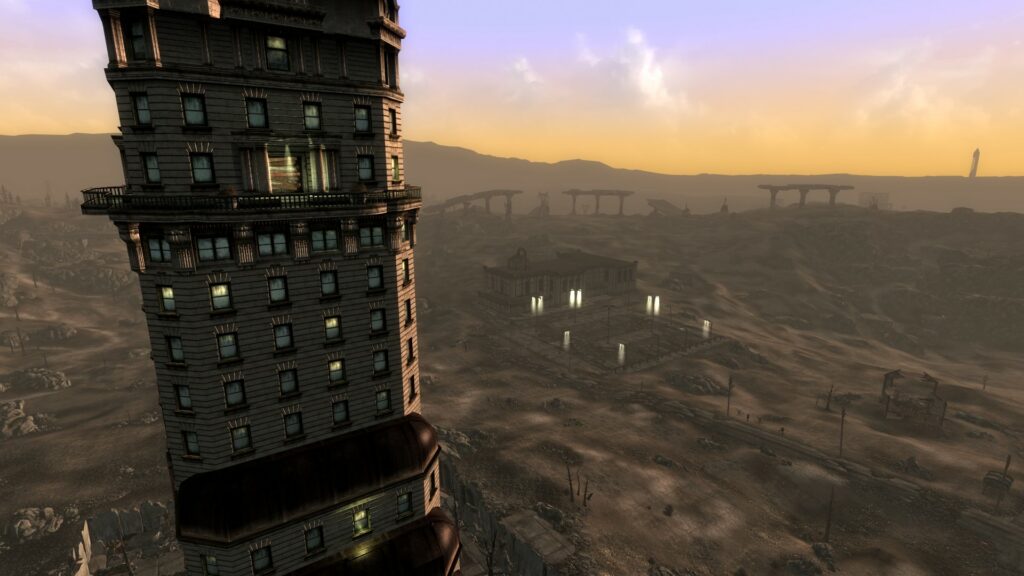
Roy can still work basically as he is. Just make him a de facto leader of the slums and say that his plan to wipe out Tenpenny is being done under the guise of freedom and liberation. Depending on how you play, you can talk him down, help him, help then betray him, or come to some sort of new understanding with Tenpenny, likely betraying the slums themselves.
But in order for this to work, it’ll be helpful to have a foil for Roy, someone more reasonable and rational who can balance his mouth-frothing rage. Maybe we could use Bessie Lynn (one of his ghoul companions) and say that she wants broadly similar things, but she wants to handle it in a pacifist fashion with minimal bloodshed.
This gives the player two characters they can chat to who want the same things, but are at odds in the method they want to use to achieve those things. Roy is violent and unstable, making him a good ally for a combat-focused player build, or an unpleasant type working with Tenpenny who’ll be looking to put this nascent revolution down in a way that prevents another from happening—the ‘making a lesson of…’ approach.
Bessie will be more about talking things out (for the more diplomatic player types), but if that doesn’t work she’ll also be on-board with the idea of armed revolt if it means freedom for her people. Guns will be heavily restricted—can’t have the plebs taking pot shots at the tower, after all!—so they’ll require some level of outside help.
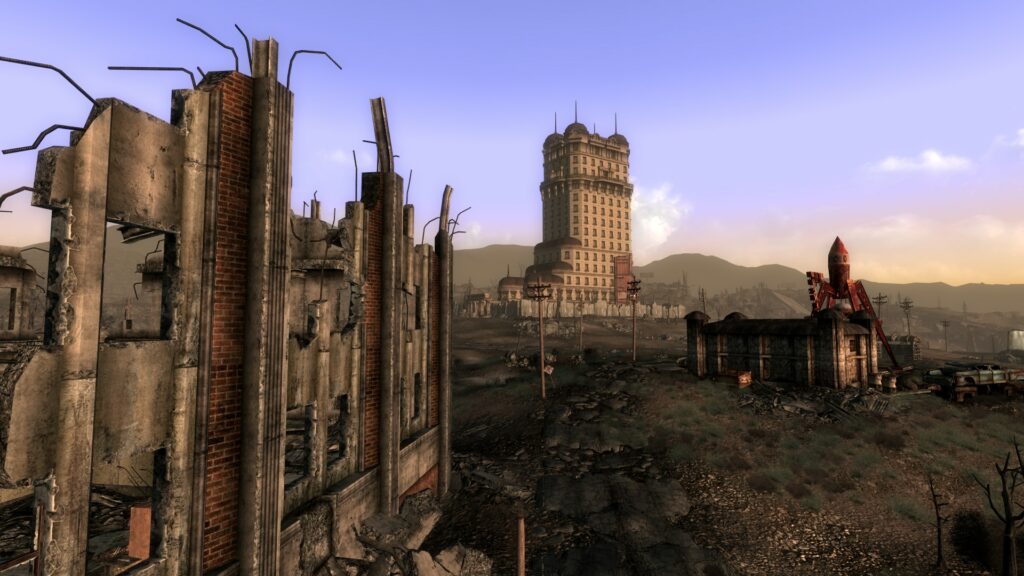
The player can provide some of this, potentially even allying the people down here with Canterbury. The people over there can supply additional weapons smuggled in via means I’ll get to momentarily involving one of the DLCs, along with other important supplies such as fresh water (would require that Dad’s quest be handled first, again tying that into the wider world in a way that makes sense).
A quick aside: I said at the start that I’d be trying to fit my changes in with the world in a way that roughly keeps things as they are now, and without going too far into ‘this is what I’d do if I had an unlimited budget’. On that subject, constructing a large shanty town around the tower would certainly fall into the latter.
However, it’s also true that Bethesda (and other big studios with a lot of money) likes to throw money around on utterly pointless big-name Hollywood actors like Liam Neeson. Frankly, if they stopped doing stupid shit like that and used that money for actual development of the game, we could have extra content like a much-enlarged Tenpenny Tower that actually has some interesting quests and moral dilemmas for the player to enjoy.
Moving on…
Let’s talk a bit more about the factories in use both here and over at Canterbury Commons. If we say that Tenpenny’s people have taken over the nearby Robco factory and are using it to refurb and repair robots, then that gives us a direct competitor for Canterbury Mega Commons.
First, they need materials. Scrap metal is useful, but assuming we’re not shunting the timeline backwards by 100+ years, it’ll also be in short supply because most of it should already have been scavenged, at least in the convenient local regions. That means we need a supply process of some sort.
We can still say they scavenge, sending people further and further afield to see what they can find, but to keep up with demand they’d need a steady supplier. So how about we take a look at one of the DLCs? Specifically, the Pitt. Upon starting the DLC you meet Wernher, and after some minor faffing about you take a handcar to the Pitt.
What does this tell us? That there’s an intact rail line all the way to a city some 200 or more miles away. This seems unlikely given the scale of the nuclear exchange, but I’m willing to run with it simply because we can fix the issue by saying some of the factions in the world collaborated to rebuild and repair the rail lines, same as the NCR is doing out west in New Vegas.
With that in mind, we can say that people got several locomotives up and running, using recovered fusion tech. Remember, fusion was a late development and not rolled out everywhere (regardless of Bethesda’s lore retcons on the matter), so let’s say people eventually stumbled across some working prototypes and pushed them into service, opening vast swathes of the region up to each other.
Additionally, we could say that they took one of these locomotives apart and moved the fusion engine over to Tenpenny in order to hook it up and provide power for both the tower and the facility nearby. This will be built upon some more in a later chapter.
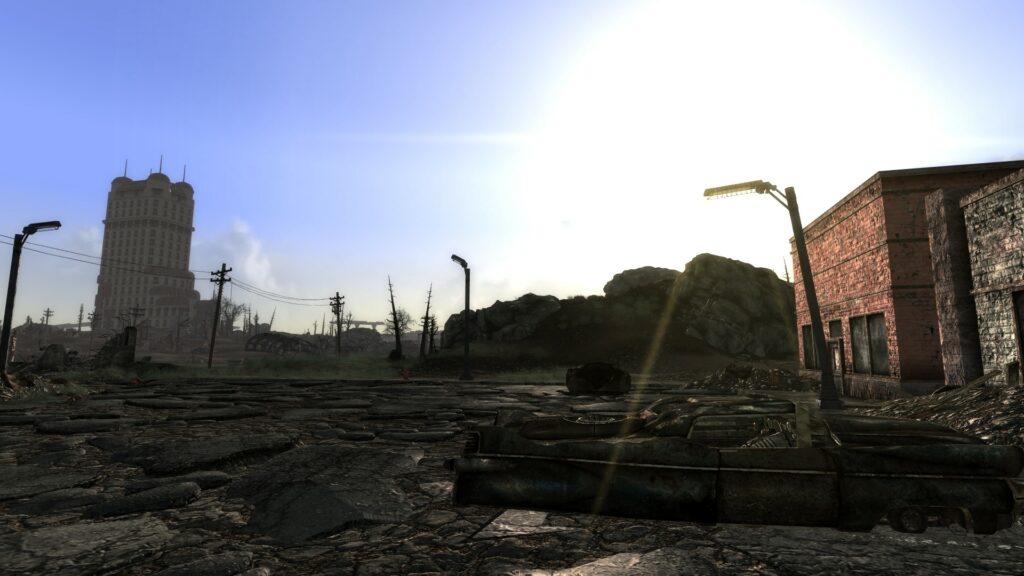
Before I go further, a quick aside to talk about New Vegas and its DLC. Remember how each DLC was foreshadowed in some way? You either hear about a character, run across graffiti and other clues, or otherwise find hints about them? Talk to Veronica and she tells you of Father Elijah, for example, before you meet him at the Madre.
Ulysses stayed at Wolf Horn Ranch for a time, plus you can find the wreckage that later became the entrance to the final DLC over the west side of the map. Joshua Graham is regularly mentioned and you’ll meet him in Honest Hearts. And the very existence of Nightstalkers and Cazadores points to the Big MT’s experiments. There are others, such as the BoS Bunker south of Camp Forlorn Hope, and so on.
Fallout 3 does none of this for the most part, instead opting for the usual approach; dump cool shit down as a standalone theme park attraction that barely fits into the main world at all. That said, the Pitt can easily be attached to the main world and setting, so let’s do that.
The Pitt is a steel mill. What do our robotics and other metalworking factories require? Steel and other metals! A rail line exists between these two locations, allowing for deliveries of raw materials. This can potentially lead to conflict between Canterbury and Tenpenny as they attempt to disrupt each other’s operations by targeting shipments—this will be easier for Tenpenny, for reasons I’ll get to in a sec.
We’ll hear stories of the Pitt and the working conditions there, giving us hints as to the future DLC. Likewise, rather than taking a handcar some 200+ miles, we can easily have Wernher smuggle the player on-board a train bound for the Pitt, saying he can’t get you on for a legit trip because the trains are searched on arrival, necessitating a jump off before reaching the end station.
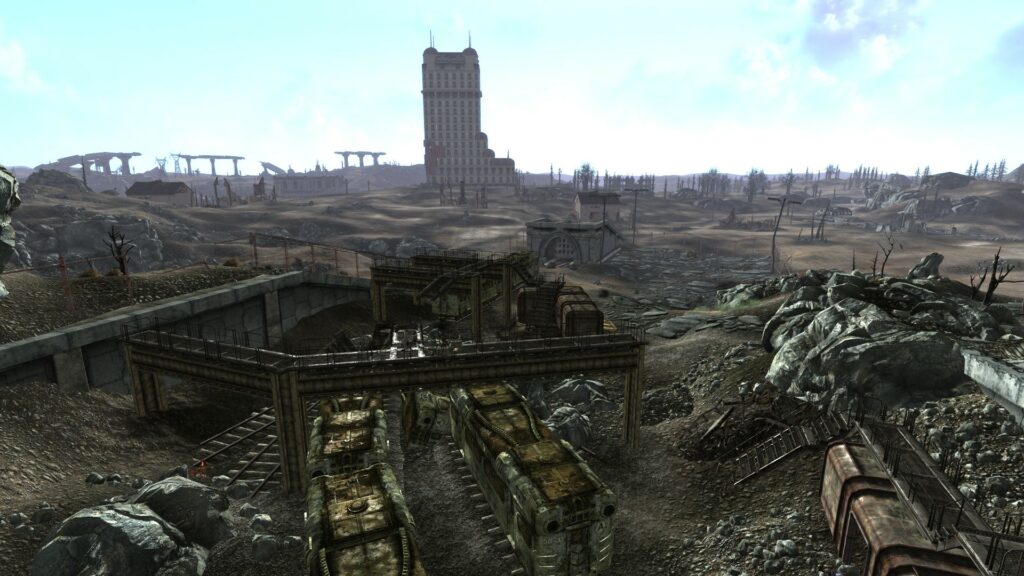
Our Wasteland factions need goods to trade with the Pitt, of course, so we’ll say that Canterbury trades various life necessities like large shipments of food and water (something Ashur will want to have control over to keep his slaves in line), and Tenpenny’s crew trades both slaves (they’ll be working with Paradise Falls and others, more on this later) and potentially some amount of robotics or maybe even technical knowhow.
Canterbury Commons trades out of necessity because they require the materials to remain competitive with Tenpenny. They hear stories of the poor conditions in the Pitt, but can’t do much about it. Tenpenny is effectively colluding with Ashur, however, because he’s got a good thing going on here.
A fragile balance exists simply because Ashur requires commodities from both settlements here in DC and can’t risk destroying a financially beneficial relationship with either. This nicely sets up for the DLC, where the player will have options for tipping that balance and putting someone new in charge who’ll be sympathetic towards one side or the other.
Changes the player makes in the Pitt will reflect in the ending slides (well… if Fallout 3 had bothered with those instead of passing moral judgement on the player) depending on how they complete quests in the base game for both settlements, giving some measure of consequence for the decisions made that will then be rolled into a canon ending to be used as the basis for Fallout 4.
Finally, the shipments for Canterbury will be dropped at the train tunnel up on the north edge of the map, allowing them to be offloaded and hauled over to Canterbury Commons. The train will then use one of the tunnels south, coming up in Warrington Station near Tenpenny Tower, allowing them to unload the rest of the shipment.
This keeps both factions away from each other to a reasonable degree, since Ashur is well aware they don’t get along. Additionally, sympathisers in the Pitt have been smuggling small quantities of weapons into Warrington for Roy / Bessie to use, which will be expanded upon when the player reaches the DLC and meets the people organising their own revolt. Add to this the player allying Canterbury with Roy / Bessie, and we have a nice little powder keg ready to go up.
Last of all, I mentioned that Tenpenny has an easier time disrupting Canterbury than the reverse. This is because Tenpenny’s shipments come in via underground rail lines direct to his own station (we can say these lines were far enough away from the epicentre of the nukes to still be intact), but Canterbury has to haul theirs from the north right over to the east, leaving them vulnerable to attack.
As mentioned in the previous chapter, Canterbury is looking to expand operations and needs additional protection. This is a large part of why, to help protect against Tenpenny’s crew and their attacks on Canterbury’s caravans. We’ll talk more about Talon Company in a later part, but suffice to say they’re the muscle behind Tenpenny’s operations.
Next, we’ll dig into Rivet City.
If you enjoy my work, consider buying me a coffee, or jump onto my newsletter to receive updates, free chapters, stories, and other goodies.


